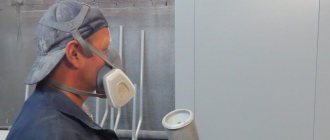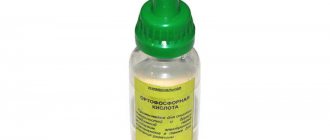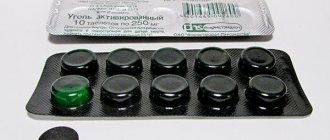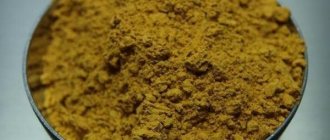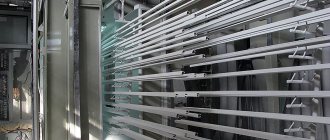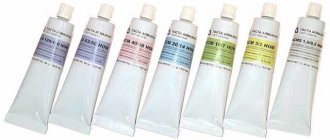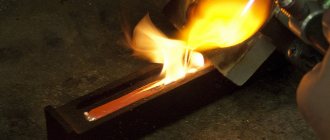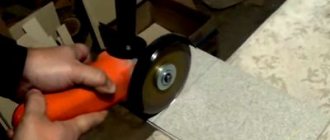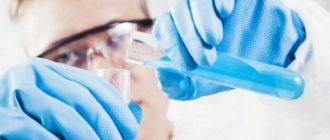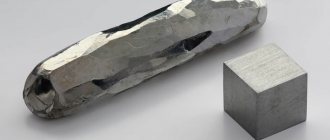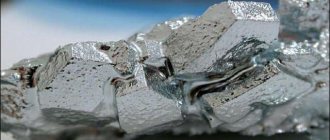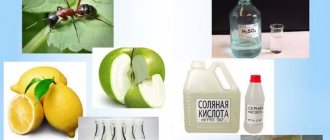Both iron and even steel in humid air are gradually covered with a brownish-brown loose film of rust - they undergo corrosion
. Sometimes a completely new thing, forgotten in the open air or left at the dacha for the winter, becomes covered with a brown scab. Rust, which consists of a mixture of iron oxide Fe 2 O 3 and iron metahydroxide FeO (OH), does not protect its surface from further “aggression” from air oxygen and water, and over time the iron object is completely destroyed.
Secrets of rust removal.
The easiest way to remove rust is by treating it with a dilute aqueous solution of hydrochloric or sulfuric acid containing the acid corrosion inhibitor methenamine.
Inhibitors
(from the Latin “ingibeo” - I stop, restrain) are substances that inhibit a chemical reaction (in this case, the reaction of dissolving a metal in an acid). But the corrosion inhibitor does not interfere with the interaction of the acid with the iron oxide and hydroxide that makes up rust.
If window latches, small bicycle parts, bolts or nuts are
, they are immersed in a 5% acid solution with the addition of 0.5 g of methenamine per liter, and this solution is applied to large items with a brush.
Using solutions of strong acids without an inhibitor is risky
: You can dissolve not only rust, but also the product itself, since iron is an active metal and interacts with strong acids, releasing hydrogen and forming salts.
Potato tops
can also be used as an acid corrosion inhibitor when removing rust . To do this, place fresh or dried potato leaves in a glass jar and fill it with 5-7% sulfuric or hydrochloric acid so that the acid level is higher than the crushed tops. After mixing the contents of the jar for 15-20 minutes, the acid can be drained and used to treat rusty iron products.
"Rust Converter"
turns it into a durable brown surface coating. Apply a 15-30% aqueous solution of orthophosphoric acid to the product with a brush or spray and allow the product to air dry. It is even better to use phosphoric acid with additives, for example, 4 ml of butyl alcohol or 15 g of tartaric acid per 1 liter of phosphoric acid solution. Orthophosphoric acid converts rust components into iron orthophosphate FePO 4, which creates a protective film on the surface. At the same time, tartaric acid binds some of the iron derivatives into tartrate complexes.
Items heavily corroded by rust
, process:
# with a mixture of 50 g of lactic acid and 100 ml of vaseline oil. The acid converts iron metahydroxide from rust into a salt soluble in petroleum jelly - iron lactate. The cleaned surface is wiped with a cloth moistened with petroleum jelly; # with a solution of 5 g of zinc chloride and 0.5 g of potassium hydrogen tartrate in 100 ml of water. Zinc chloride in aqueous solution undergoes hydrolysis and creates an acidic environment. Iron metahydroxide dissolves due to the formation of soluble iron complexes with tartrate ions in an acidic environment;
# Unscrew rusted nuts
Wetting with kerosene, turpentine or oleic acid helps. After some time, the nut can be unscrewed. Then you can set fire to the kerosene or turpentine with which it was moistened. This is usually enough to separate the nut and bolt. The latest method: apply a very hot soldering iron to the nut. The metal of the nut expands and the rust moves away from the thread; Now you can put a few drops of kerosene, turpentine or oleic acid into the gap between the bolt and the nut, and this time the nut will turn off with a wrench.
# There is another way to separate rusty nuts and bolts
. A “cup” of wax or plasticine is made around the rusted nut, the edge of which is 3-4 mm higher than the level of the nut. Pour diluted sulfuric acid into a cup and add a piece of zinc. After a day, the nut can be easily unscrewed with a wrench. A cup of acid and zinc metal on an iron base is a miniature galvanic cell. The acid dissolves the rust, and the resulting iron cations are reduced on the surface of the zinc; at the same time, the metal of the nut and bolt does not dissolve in the acid as long as the acid has contact with the zinc, since zinc is a more reactive metal than iron.
To prevent rusting
carpentry or plumbing tool, it is lubricated with a brush with a solution of 10 g of wax in 20 ml of gasoline. The wax is dissolved in gasoline in a water bath, without using open flame (gasoline is flammable).
The polished instrument is protected by applying a solution of 5 g of paraffin in 15 ml of kerosene to its surface. An old recipe for ointment to protect metal from rust
is as follows: melt 100 g of pork fat, add 1.5 g of camphor, remove the foam from the melt and mix it with graphite, ground into powder, so that the composition turns black. Lubricate the instrument with the cooled ointment and leave it for a day, and then polish the metal with a woolen cloth.
In order not to suffer in the future by unscrewing fasteners with rusted threads
, it is lubricated with a mixture of Vaseline and graphite powder.
Instead of Vaseline, you can use any other fatty lubricant of a neutral or slightly alkaline type. Bolts and nuts with such a lubricant can be easily removed even after several years of exposure to the open sky. The technology for washing heat exchange equipment is both simple and effective: -Attach the washing unit to the heat exchanger;
-Prepare a solution of the required reagent and heat it to the specified temperature; -Turn the washer unit into circulation mode according to the operating instructions; -Make sure that all the sediment has dissolved, -(special test kits are included for this); -Neutralize and drain the spent solution; -Rinse the heat exchanger; -Disconnect the sink installation from the heat exchanger; After this, you will be convinced that the heat exchanger has completely returned to its original characteristics. In addition to significantly increasing the operating efficiency of any type of heat exchanger, installations and reagents produced by the BWT concern increase their total operating time without damaging the plates and sealing gaskets. For economic benefit. It is more profitable to service heating or refrigeration equipment, air conditioning systems, and so on yourself. To do this, you need to buy installation and reagents. Since the price for this type of service is quite high. By comparing the cost of flushing a heat exchanger or other equipment and purchasing maintenance equipment, you can see the difference in price. You also have the opportunity to do annual maintenance or maintenance as needed at your facilities, refrigeration or heating equipment, washing machines (installations) as well as equipment for washing collapsible plate heat exchangers, as well as for washing brazed heat exchangers, boilers, boilers, heating systems, as well as hot water supply systems (DHW). There are several models of washing machines for cleaning heat exchangers, as well as Drugov’s heat exchange equipment, the choice of installations depends primarily on the volume of the container being washed, but in practice it is advisable to buy an installation with a power reserve of the installation itself. Since in the practice of servicing objects, the problem almost always arises in cleaning a larger volume of the washed container. Method of cleaning heat exchangers: dismountable cleaning, washing of heat exchangers, in-place washing of heat exchangers. These installations are designed for non-dismountable cleaning of heat exchangers and other equipment. s using BWT a. The question often arises of how and with what you can rinse and clean the heat exchanger without damaging the sealing plates in the heat exchanger itself. How to perform seasonal maintenance of a heat exchanger, boiler, boiler, or service other heat exchange equipment b. How to choose a product, solution, composition, reagent for cleaning the heat exchanger. How and with what to rinse and clean the boiler.
To carry out the process of washing and servicing heat exchange equipment, the BWT concern produces a series of units of different capacities, allowing for the washing of heat exchangers and pipelines of any volume. All BWT sinkless units are made from industrial plastic and are primarily used in HVAC systems to remove lime and other types of deposits from the surface of the plates without the need to disassemble and open the plate heat exchanger. Some of these devices are equipped with a system capable of changing the direction of flow of the cleaning solution. These installations are well suited for service organizations that service boiler houses and various facilities where the problem of cleaning equipment arises when working in a technological process; the installations can be used for flushing the boiler, and the heating system can be easily cleaned: a collapsible plate heat exchanger, as well as a brazed heat exchanger. Washing installations can be used in both industrial and domestic applications: for private use in private cottages, when servicing heating systems.
Scale is solid deposits that form on the inner walls of the pipes of steam boilers, water economizers, superheaters, evaporators and other heat exchangers in which water containing certain salts is evaporated or heated. An example of scale is the hard deposits found inside teapots.
Types of scale According to the chemical composition, scale is predominantly found: carbonate (carbon dioxide salts of calcium and magnesium - CaCO3, MgCO3), sulfate (CaSO4) and silicate (silicic acid compounds of calcium, magnesium, iron, aluminum).
Damage from scale The thermal conductivity of scale is tens and often hundreds of times less than the thermal conductivity of the steel from which heat exchangers are made. Therefore, even the thinnest layer of scale creates a large thermal resistance and can lead to such overheating of the pipes of steam boilers and superheaters that bulges and fistulas form in them, often causing rupture of the pipes.
Fighting scale The formation of scale is prevented by chemical treatment of water entering boilers and heat exchangers.
The disadvantage of chemical water treatment is the need to select a water chemistry regime and constantly monitor the composition of the source water. Also, when using this method, it is possible to generate waste that requires disposal.
In recent years, methods of physical (reagent-free) water treatment have been actively used. One of them is a technology that repels hardness ions dissolved in water from the walls of equipment pipes. In this case, instead of a crust of hard scale, suspended microcrystals are formed on the walls, which are carried out of the system by the flow of water. With this method, the chemical composition of water does not change. There is no harm to the environment, there is no need for constant monitoring of the system.
Remove scale using mechanical and chemical methods. Acetic acid dissolves scale perfectly; it essentially reacts with the salt on the walls of the kettle and forms other salts, but these are already freely floating in the water. For example, scale in a kettle. It needs to be mixed with water in a ratio of 1:10 and the kettle boiled over low heat. The scale will dissolve before your eyes. Citric acid is good for dissolving impurities that have settled on water purification filters. Of course, it must be dissolved in water. Adipic acid is usually used in production and it is the basis of most household descaling products.
When cleaning mechanically, there is a danger of damaging the protective layer of metal or even the equipment itself, since the boiler or heat exchanger must be completely or partially disassembled for cleaning. Without a doubt, this is a very expensive method, because... Often the cost of equipment downtime is much higher than the cost of cleanup.
Chemical cleaning can be used without completely disassembling the boiler or heat exchanger. But there is a danger that too long exposure to acid can damage the metal of the boiler, and shorter exposure will not sufficiently clean the surfaces.
Washing machines installations pumps stations equipment and reagents for washing collapsible plate heat exchangers, for washing brazed heat exchangers Washing the heat exchanger, Cleaning the heat exchanger from scale and deposits equipment for washing heating systems, Installation BOY-C 30, Kaloxi cleaning liquid, scale, rust, humus, bacteria, means for removing lime deposits, cost, Washing boiler heat exchangers, Washing a food heat exchanger, pump for washing boilers, acid for washing a heat exchanger, Washing a gas boiler heat exchanger, Chemical cleaning of process equipment and communications, as well as a chiller, flushing pump for descaling, apparatus for washing secondary heat exchangers at wall units, reagents for washing heat exchange equipment, remove scale from the boiler, descaling a steam gas boiler, cleaning methods for flushing the heat exchanger, remove scale, Method for cleaning the boiler heat exchanger, descaling agent, Chemical methods for descaling, clean the boiler from scale, chemical pumps, pumps for pumping chemicals, pumps for chemical flushing, chemical flushing method, boiler rooms anti-scale, liquids for flushing boiler heat exchangers, Maintenance of heat exchangers, flush the heat exchanger, cleaning plate heat exchangers, deposits in the heat exchanger, cleaning heat exchangers,
Before you start painting metal products, you need to properly prepare the surface. Preparing metal for painting is carried out using different technologies. But regardless of the processing scheme, first of all the item is freed from rust.
Corrosion is classified according to the degree of damage to steel as follows:
- Corrosion stains: characterized by shallow penetration depth. Such corrosion spreads broadly, not deep into the iron.
- Pitting is small spots that penetrate deep into the body. With further development of pitting corrosion, through holes appear on the steel.
- Through corrosion is through damage to the material.
- Under-film corrosion: pockets of rust form under the surface of the coating. Layers of paint in places where rust has formed swell. But sometimes subfilm corrosion remains unnoticed until the steel undergoes complete destruction.
Material processing
Treating the material against rust before painting can be done using the following methods:
- mechanical;
- chemical;
- thermal.
Benefits of phosphoric acid
Phosphoric acid successfully copes with rust on metal, enamels and earthenware.
Products made from these materials can be successfully cleaned from corrosion using phosphoric acid. The acid acts delicately without causing damage to the enamel. Helps protect metal from further destruction by rust.
This product is known as a cleanser: phosphoric acid is used in everyday life to make plumbing fixtures white. Bathtubs and washbasins yellowed by rusty water can be restored using this method. You need to clean the plumbing with acid additionally diluted in a ratio of 1 to 5 with water. This will prevent the enamel from being destroyed when interacting with an overly aggressive acidic environment. Be careful when using even additionally diluted phosphoric acid in enclosed spaces.
Attention!
Phosphoric acid is absolutely not suitable for processing acrylic! Pay attention to what your bathtub is made of; you may not want to use this rust bleaching method. Phosphoric acid has long been actively used in the automotive industry. Removing rust without sanding means preserving the enamel on the surface and saving on its restoration.
Mechanical cleaning
The mechanical method of removing corrosion has proven to be the most effective. Metal rust removal is done manually or using power tools. There are several ways to remove rust mechanically.
1. Cleaning the surface with wire brushes. It is used for removing small pockets of corrosion and cleaning and for primary treatment of surfaces covered with a thick layer of rust. The quality of cleaning is not very good; the brushes do not remove scale at all. In addition, the processing process generates a lot of dust.
2. Abrasive processing of metal using grinding discs. Used for small areas of corrosion. If high quality discs are used to perform the operation, the result is good. Processing metal with an abrasive tool has two disadvantages:
- consumption of quality materials;
- requirements for certain skills to perform work.
3. Anti-corrosion treatment of metal using a sandblasting unit: bombardment of corrosion centers with a jet of sand supplied under pressure, the so-called. The main elements of a sandblasting installation are a container with sand and a sandblasting gun. A small compressor is sufficient to operate the sandblasting unit.
Sandblasting
Sand is taken from ordinary river or construction sand. It should be dried thoroughly before use. Sand can be reused after sifting, but the cleaning efficiency in this case is reduced several times. And the amount of dust increases by the same amount.
Sandblasting removes not only all rust, but also scale, carbon deposits, and layers of old paint. When processing places that are inaccessible to a grinder and sandpaper (for example, the junction of two parts), this method is the only possible one.
4. Water jet treatment of metal (water sand blasting). Rust is removed under the influence of a jet of a mixture of water and abrasive. Waterjet treatment is classified according to intensity:
- under ultra-high: corrosion and all coatings previously applied to the treated surface are completely removed;
- under high pressure: removes most of the old coating and corrosion. But areas of particularly durable coating and black oxides (magnetites) may remain;
- under low pressure: an economical method in terms of abrasive consumption, but after drying, traces of secondary rust remain on the treated surface.
Waterjet surface treatment is an industrial method. Unlike sandblasting, such an installation cannot be built in a garage.
How to clean rust using phosphoric acid at home?
Cleaning must be done extremely carefully, otherwise the metal may become thinner or even holes may form on the car. Therefore, it is necessary to limit the degree of exposure of orthophosphoric acid to the metal. When preparing the surface for processing, grinding discs with too strong abrasive properties should not be used. This can damage the surface, which will no longer be able to withstand subsequent cleaning.
Before application, it is better to protect the rest of the surface from exposure to such a strong substance as orthoosphoric acid. Accuracy and precision of the impact will help to avoid additional expenses for the restoration of a surface that is not rusted, but has been damaged by acid.
If everything is done correctly, the surface will be completely free of rust, which would sooner or later destroy the metal. Phosphoric acid can be harmful to the human body, so all work with it is carried out with strong gloves and a mask. If phosphoric acid gets on your clothing, it is better to remove it immediately to stop the poison from getting on your skin.
There are three main methods of using phosphoric acid to remove rust from metal parts. The choice of method depends on the size, degree of damage and other properties of the item being cleaned. Cleansing can be achieved by completely immersing the object in an acidic environment. The surface can be sprayed with phosphoric acid from a spray bottle or applied with a roller. Rust can be removed mechanically by then treating the part with acid.
Chemical treatment of steel
This method is based on removing rust under the influence of chemically active substances. One of the related types of processing is. The compositions are applied to the surface using a brush or spray. Rust removers fall into two categories:
- washable. The disadvantage of such compositions is that when the surface comes into contact with water, new sources of corrosion may arise. Therefore, after washing, the material must be quickly and thoroughly dried and treated with anti-corrosion agents;
- indelible. They are also called soil converters. The product of a chemical reaction cannot be called a full-fledged primer, but nevertheless, such treatment eliminates subsequent washing, that is, mandatory contact with water is completely eliminated.
- An aqueous 5% solution of sulfuric or hydrochloric acid removes rust well. But a corrosion inhibitor is necessarily added to it - a substance that slows down the chemical reaction. Most often, methenamine is used as an inhibitor. It should be added in an amount of 0.5 g per liter of solution. Acid solutions cannot be used without an inhibitor: as a result of such treatment, not only corrosion, but also the material will dissolve.
- An interesting result is obtained by treating the metal with orthophosphoric acid. If a 15-30% solution of orthophosphoric acid is applied to the surface to be treated, then under its influence the rust will turn into a durable coating. This happens because a chemical reaction produces iron orthophosphate, which creates a brown protective film on the surface. For the best effect, butyl alcohol (4 ml per liter of solution) or tartaric acid (15 ml per liter of solution) should be added to the solution.
- Surfaces heavily affected by rust are treated with a mixture of:
- lactic acid - 50 g; see this article.
Is it necessary and why to wash off the composition?
Rust modifiers are chemical products consisting of special compounds. In the process of exposure of corrosion areas to the rust converter, the oxide forms of iron are converted into phosphates.
In order for the process to be as successful as possible, the surface must be prepared - it is thoroughly cleaned, trying to remove the loose layer .
After the active reaction of the chemical and rust has finished, you can begin washing off. This is done after the metal surface has dried. At this stage, the surface is cleaned with a stiff brush and treated with the selected product.
Converters can come in various forms: from liquids to thick pastes and gels. The texture of the product affects the ease of use and distribution of the drug over the surface.
Their composition can be either acid-free or acid-containing . Most often, the composition of acid modifiers is orthophosphoric acid.
Taking into account the composition of the drug used, it is determined whether a wash is necessary and what type. Acids are chemically active substances whose reaction can continue on the metal even after painting.
Heat treatment of surface
An oxygen-acetylene burner is used for heat treatment of steel. As a result of exposure to flame, almost all mill scale is removed. But, unfortunately, not all rust burns off, so this method is practically not used in modern paint systems.
Content
- Why does scale form?
- How often is flushing required?
- Popular cleaning methods
- Liquids for flushing heat exchangers
Introduction
The service life of a gas boiler depends not only on careful operation, but also on timely cleaning of its components and assemblies. A heat exchanger in constant contact with hot coolant is most susceptible to the formation of scale and various deposits. In this article we will talk about the reasons for the formation of plaque, symptoms of the need for cleaning, how to flush the heat exchanger of a gas boiler and what reagents are used.
Flushing is necessary for all types of heat exchangers: tubular and plate, primary and secondary, shell-and-tube and bithermal. Copper and steel, aluminum and cast iron - all of them are, to one degree or another, susceptible to the formation of deposits and scale.
Why does scale form?
The main reason for the appearance of scale on the walls of heat exchangers of gas boilers is the use of hard lime water. As a rule, the water supplied to the heating system is not well purified and contains calcium and magnesium salts, as well as ferric iron, in dissolved form. When exposed to high temperatures, these impurities crystallize on the walls of the heat exchanger, forming a layer of deposits and rust.
Photo 1: Deposits inside bithermic copper heat exchanger
If the coolant used in the heating system undergoes at least some filtration, then water sometimes enters the DHW circuits of double-circuit boilers and bithermic heat exchangers without any purification. That is why these elements are especially susceptible to scale formation.
Why is scale on the walls of the heat exchanger dangerous? Several factors can be identified in the detrimental effect of deposits on the operation of the heating system as a whole and its individual devices in particular:
Increased gas consumption
The mineral deposits that make up the scale have much lower thermal conductivity compared to the metal from which the heat exchanger is made. Based on this, it will take more energy to warm up the coolant, and therefore the volume of gas burned will increase. Just 1 mm of deposits increases heating costs by 10%.
Heat exchanger overheating
It is assumed that the coolant coming from the return line cools the heat exchanger, removing heat into the heating system. Scale interferes with normal heat exchange and the boiler automation commands to heat more strongly in order to achieve the required temperature in the supply line. Working for a long time at extreme temperatures, the heat exchanger quickly wears out and fails.
Additional load on heating equipment
The formation of scale on the walls of the heat exchanger reduces the effective diameter of the channels and interferes with the normal circulation of the coolant. As a result, the load on the circulation pump increases, which leads to its premature wear and failure.
Photo 2: Scale and rust on the walls of the heating system pipes
The problem of scale formation in gas boilers is quite serious and can hurt the owner’s pocket if it is not eliminated in time.
Return to contents
How often is flushing required?
Many popular manufacturers of gas boilers such as Navien, Baxi, Ariston, Vaillant indicate the frequency of flushing the heat exchanger in their operating instructions. However, real operating conditions often make their own adjustments. Experience with hard water shows that the heat exchanger should be washed every season. To avoid this problem in the middle of a cold winter, it is recommended to flush immediately after or before the start of the heating season. The following are characteristic signs that indicate that the heat exchanger of your gas boiler needs cleaning:
Gas consumption has increased
The resulting scale reduces the thermal conductivity of the heat exchanger, thereby forcing the gas boiler to burn more fuel to achieve the set temperature.
Burner always on
An increase in burner operating time may also indicate the presence of scale preventing normal heating of the coolant.
Rumble and interruptions in the operation of the circulation pump
Reducing the effective diameter of the heat exchanger channels makes it difficult to pump the coolant to the circulation pump. Its operation in maximum mode may be accompanied by hum and interruptions in operation.
Reduced pressure in the DHW circuit
A sign of the presence of a layer of scale in the secondary circuit of a double-circuit boiler can be a decrease in pressure in the hot water supply line.
If one or more of the above signs can be observed in the operation of your gas boiler, it is necessary to urgently flush it in order to avoid breakdowns of expensive heating system components and high costs for their repair or replacement.
Return to contents
Popular cleaning methods
There are several technologies for washing heat exchangers, which can be divided into two groups: dismountable and non-dismountable. The dismountable washing method involves removing the heat exchanger from the gas boiler and washing it separately. When using disassembly-in-place technology, nothing needs to be removed, and the cleaning process is carried out using special equipment. Let's take a closer look at the main washing methods:
Manual cleaning
Manual flushing is of the collapsible type and requires disconnecting the heat exchanger from the gas boiler. Its body is cleaned of external contaminants with metal brushes and soaked for several hours in an acid solution or a special washing liquid. The main disadvantages of this technology are the lack of circulation of the reagent during the washing process and the harmful effects of reagents on gaskets and other sealing joints. When starting a flushed gas boiler, you should make sure that all connections are tight and that there are no leaks under pressure.
Photo 3: Dismountable cleaning of the gas boiler heat exchanger
Chemical washing
Chemical (hydrochemical) flushing can be performed without dismantling the heat exchanger from the gas boiler. To remove rust, scale and other deposits, the heater is connected to a special device called a booster. This special device, equipped with a pump, pumps a chemical reagent through a heat exchanger in various directions for several hours. During this time, the chemistry included in the washing liquid completely removes the most complex contaminants without damaging the metal.
Photo 4: Chemical flushing of the heat exchanger with a booster
Hydrodynamic cleaning
This cleaning method also applies to in-place methods. Its essence lies in the fact that by connecting a special installation, water under high pressure is driven through the heat exchanger. Sometimes, to achieve a better result, the aqueous solution contains an abrasive filler. The increased speed of movement of the flushing fluid helps to effectively remove deposits from the walls of the heat exchanger.
Attention!
It is better to entrust hydrodynamic cleaning to professionals and not to do it yourself at home, since the wrong choice of pressure can lead to ruptures and damage to the heating system.
Most often, owners of gas boilers use chemical flushing of the heat exchanger using a booster. To do this, they enter into an agreement with a company that performs this type of work, or purchase special equipment and do the cleaning themselves.
Why orthophosphoric?
One of the most important advantages of using this method is the formation of a thin protective film on the metal surface after thorough cleaning of the loose mass of oxides.
Thanks to this, the treated body element will be reliably protected for some time from further development of corrosion. The principle of action of the acid is that it corrodes and absorbs iron oxide, while phosphating the surface. Therefore, after the procedure and the product has completely dried, a grayish oily film forms in place of the “saffron milk caps”.
